Key takeaways:
- Luxury retirement homes emphasize comfort and quality, offering a supportive community that enhances residents’ quality of life through various amenities and activities, including art classes.
- Art classes provide therapeutic outlets for self-expression, cognitive stimulation, and opportunities for social interaction, fostering deeper connections among residents.
- Engaging in art encourages mindfulness, boosts self-esteem, and enables communication of emotions that might be difficult to express verbally, enriching personal narratives.
- Finding the right art class is crucial for creativity, with a supportive environment fostering collaboration and friendships, transforming artistic experiences into joyful journeys.

Understanding luxury retirement homes
Luxury retirement homes go beyond just being places to live; they offer a lifestyle that emphasizes comfort, elegance, and quality. I remember visiting a beautifully designed community where every corner was thoughtfully planned, from gourmet dining options to engaging art classes. It made me wonder: how do these spaces truly cater to the varied passions and interests of residents?
In my experience, the amenities in luxury retirement homes can significantly enhance the quality of life. I recall chatting with a resident who expressed how the on-site wellness programs helped him reclaim his vitality. Isn’t it refreshing to think that these homes can encourage not only relaxation but also personal growth and exploration in one’s later years?
Moreover, luxury retirement homes often cultivate a sense of community that resonates deeply with their residents. I once facilitated a small art workshop there, and it was touching to see how art became a bridge for connection and friendship among the participants. Can you imagine how sharing creative experiences enriches one’s daily life in such a vibrant environment?
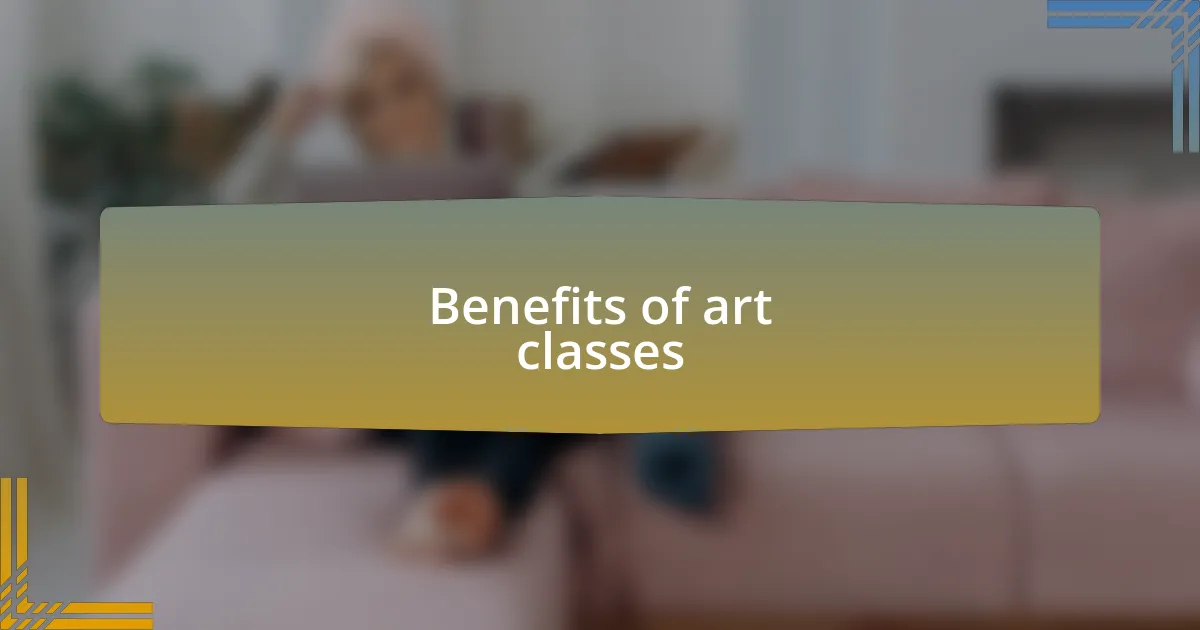
Benefits of art classes
Art classes in luxury retirement communities offer a therapeutic outlet for self-expression. I observed this firsthand during a painting class where residents poured their emotions onto canvas, transforming what could have been mundane afternoons into vibrant, creative explorations. Isn’t it fascinating how the act of creating art can be a powerful form of emotional release and self-discovery?
Additionally, engaging in art fosters cognitive stimulation and creativity, which is vital as we age. I recall speaking with a resident who shared that since she took up pottery, her mind felt sharper and more focused. This connection between creativity and cognitive health is something I find truly compelling—who wouldn’t want to sharpen their mind while having fun?
Moreover, art classes create wonderful opportunities for social interaction. I remember all the laughter and joy that filled the room during a collaborative mural project. Connecting through art doesn’t just enhance creativity; it can also nurture friendships and an overall sense of belonging within the community. How extraordinary is it to think that a shared interest can spark lasting relationships among people?
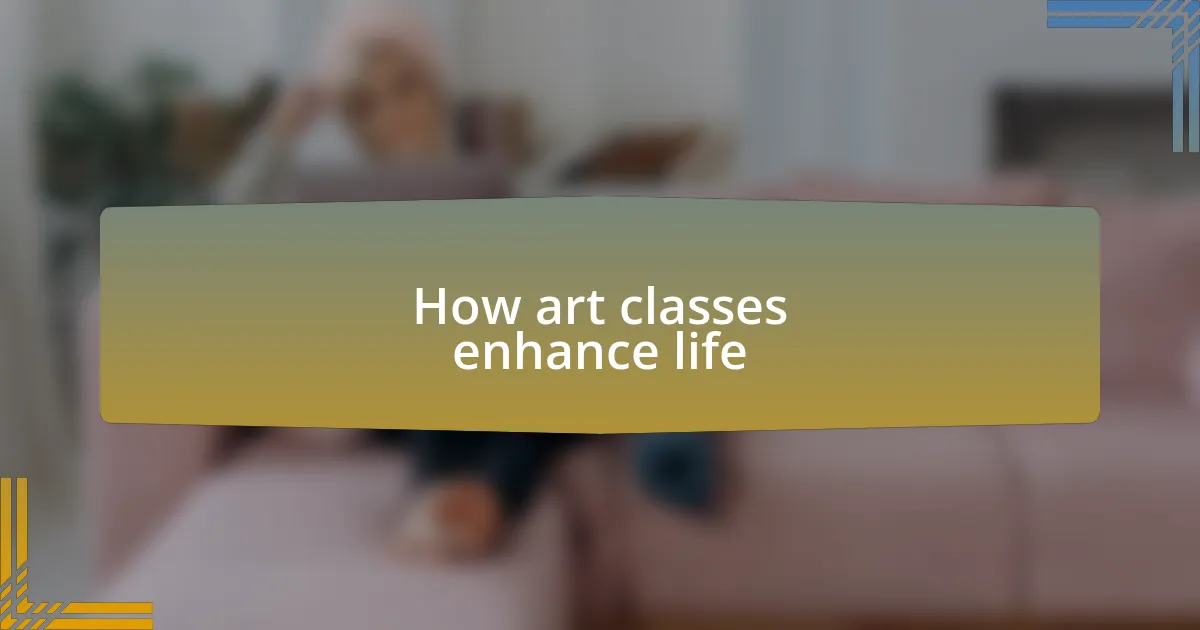
How art classes enhance life
Art classes significantly enhance life by encouraging mindfulness and presence in the moment. I remember a serene watercolor session where residents immersed themselves in the flow of the paint, losing track of time and worries. This experience underscored for me how art can be a meditative practice, providing a much-needed escape from daily stressors.
Furthermore, the journey of learning new techniques instills a sense of accomplishment and boosts self-esteem. During a recent sculpture class, I witnessed a resident proudly unveil her first clay figure. The glow on her face was infectious, and it made me realize how pursuing a new skill can reignite a sense of purpose and joy. Who wouldn’t feel invigorated by their own creative milestones?
Engaging in art also enables us to communicate feelings and stories we might find difficult to express verbally. I recall an emotional moment during a storytelling through art class, where participants shared their life stories through their creations. This experience was a poignant reminder of how art transcends words, allowing deeper connections and understanding among individuals. Isn’t it remarkable how art can bridge gaps in communication?
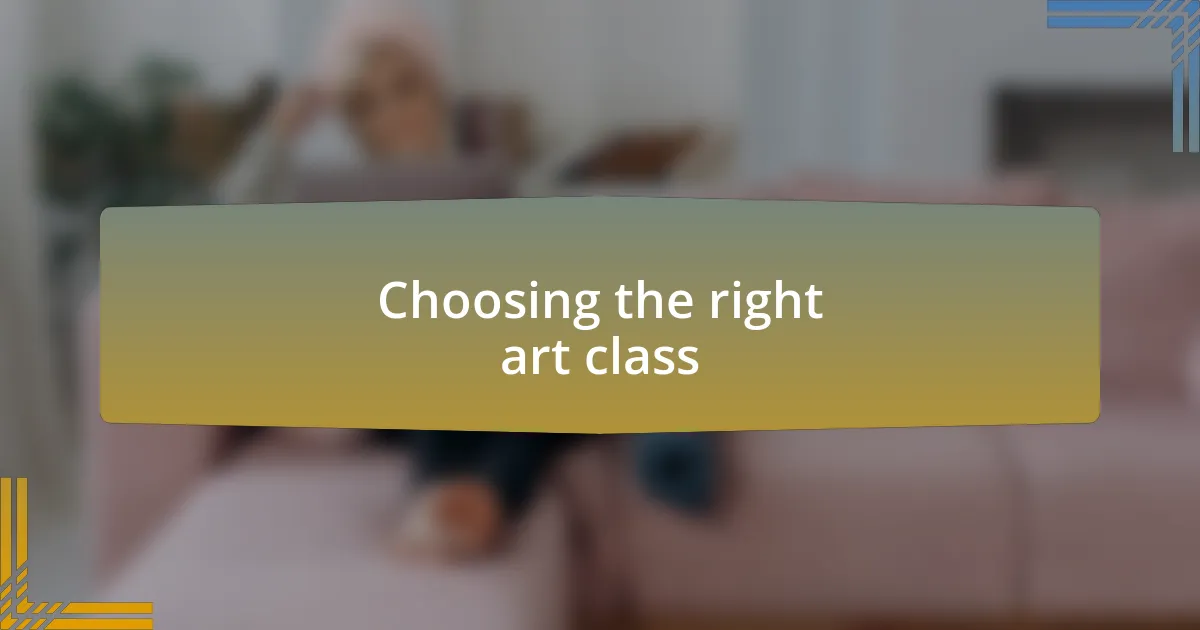
Choosing the right art class
Choosing the right art class can be a pivotal decision in enhancing your creative journey. I remember sifting through various options, feeling a mix of excitement and uncertainty. I finally realized that finding a class that resonates with your interests and skill level makes all the difference. It’s essential to consider what medium you want to explore—whether it’s painting, pottery, or something like photography—since each offers a distinct experience.
In my search, I found that not all classes are created equal. Some instructors focus on technique, while others prioritize self-expression. I once enrolled in a class where the instructor encouraged us to experiment and embrace our unique styles. That supportive atmosphere transformed my initial hesitations into joyful exploration. Have you ever felt stifled by rigid guidelines? I certainly have, and finding a class that nurtures creativity rather than constricts it is key.
Lastly, don’t underestimate the value of community within an art class. I remember walking into a studio filled with laughter and camaraderie, instantly feeling welcomed. Building connections with fellow artists not only enhances the learning experience but also fosters lasting friendships. How does being part of such a vibrant group impact your artistic journey? For me, it made art less about competition and more about collaboration and shared joy.
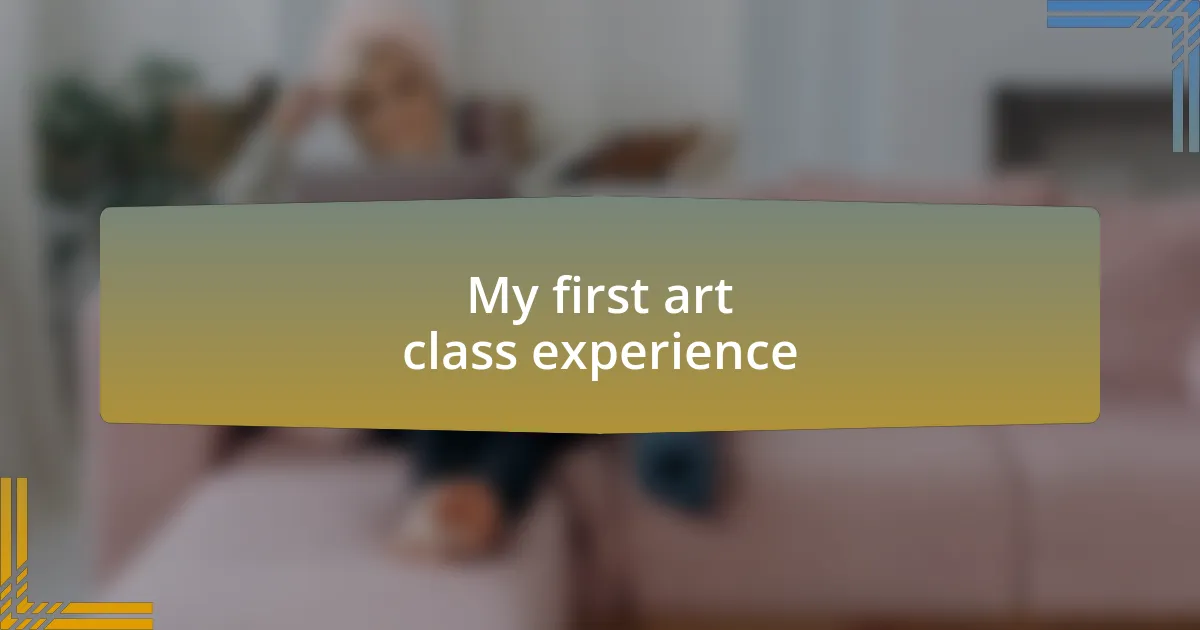
My first art class experience
I remember stepping into my first art class with a flutter of nerves and excitement bubbling in my stomach. The studio was bright, its walls adorned with vibrant paintings that seemed to whisper stories. My hands felt a bit clammy as I picked up the paintbrush for the first time, unsure of what to expect. Have you ever faced a situation where the anticipation was so strong it almost felt tangible? For me, it was like standing on the edge of a diving board, teetering between fear and exhilaration.
As I began to apply color to the canvas, I was amazed at how liberating it felt. Each stroke seemed to release a rush of emotions I didn’t even know I had, much like unburdening a heavy backpack after a long hike. I vividly recall the moment when my teacher complimented my use of color; it ignited a spark of confidence that I carried with me throughout the class. Have you ever experienced that magical moment when someone sees your potential? It was a revelation that made me realize the impact of encouragement and support in art.
The camaraderie blossomed during our group activities, where we shared laughter and occasionally our mishaps. I distinctly remember one classmate accidentally spilling paint all over the floor, and instead of panic, we erupted into giggles, turning a mishap into a memorable moment. This shared experience transformed the space into more than just a classroom; it became a sanctuary where creativity and friendship flourished. Isn’t it fascinating how art can create bonds that transcend age and background? That first class certainly set the tone for my artistic journey ahead.
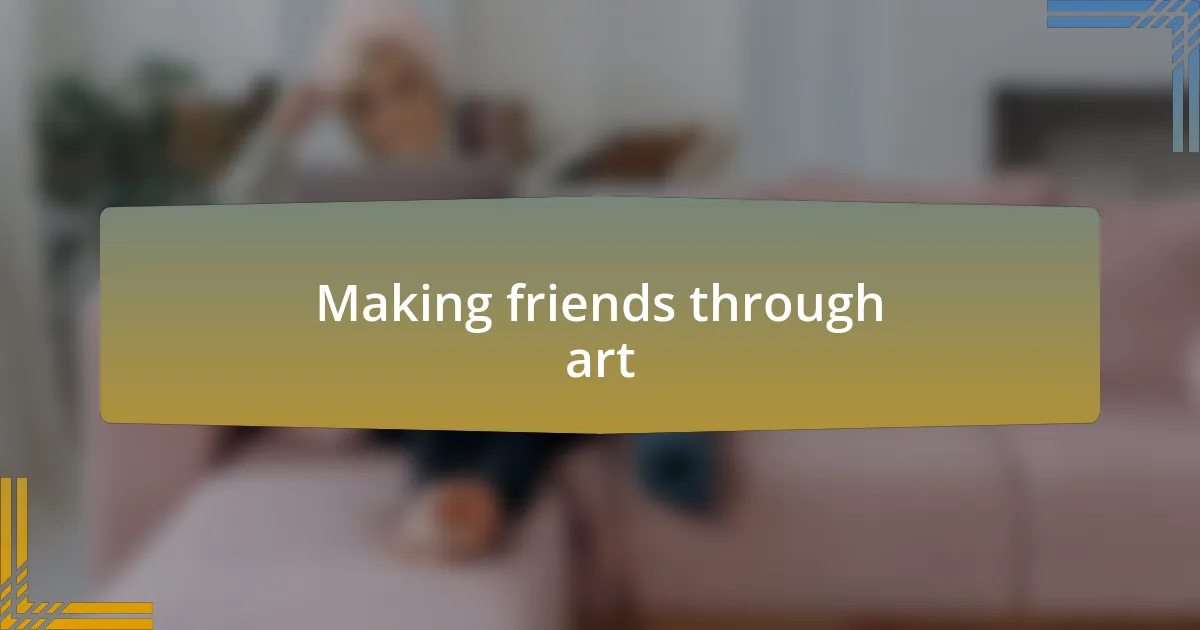
Making friends through art
In my art classes, friendships blossomed in unexpected ways. I remember one evening when we gathered for a group project, each of us painting a section of a huge mural. As we worked side by side, the easy banter and shared laughter broke down any barriers, making it feel like we had known each other for years. Have you ever felt an instant connection with someone over a shared passion? That sense of belonging was palpable.
Through our conversations, I discovered that art wasn’t just a medium for self-expression; it was a bridge to understanding each other’s stories. One classmate shared her journey of rediscovering her artistic voice after retirement, and I found myself inspired by her vulnerability. Isn’t it incredible how art encourages such openness? Creating together not only deepened our connections but also enriched our personal narratives.
I often think back to our end-of-semester exhibition, which felt like a celebration of our newfound friendships. We cheered each other on, marveling at the diverse styles and techniques each person brought to life. The pride we felt in one another’s accomplishments was electrifying. It made me realize that art truly serves as a catalyst for connection, allowing friendships to form in the most beautiful and unexpected ways.
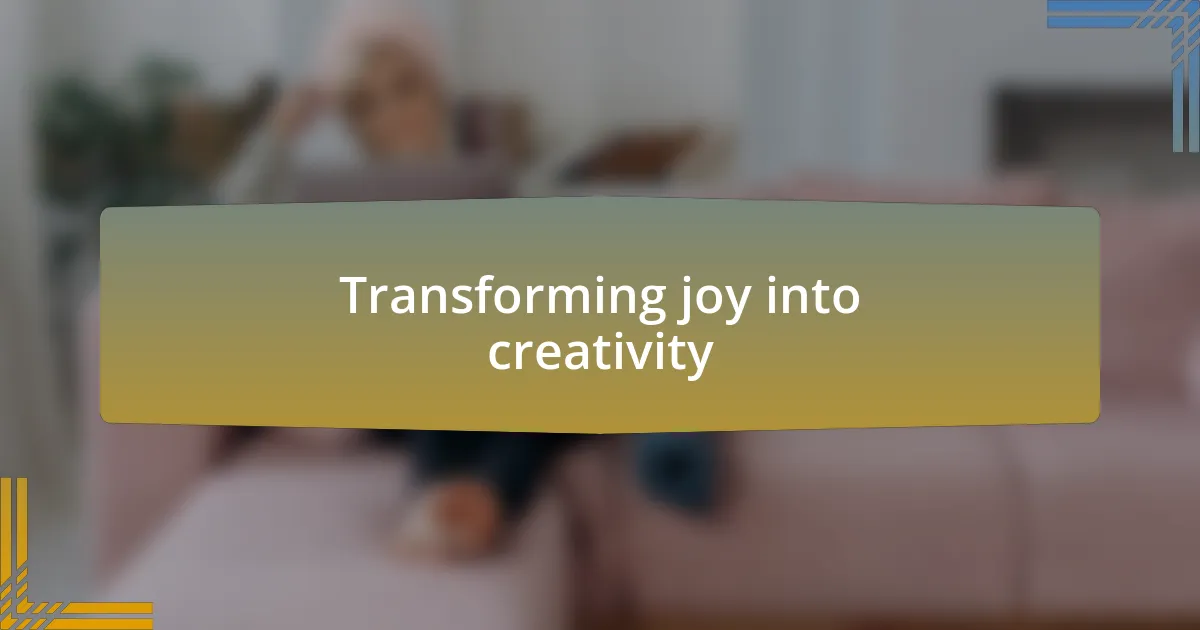
Transforming joy into creativity
Transforming joy into creativity is a journey I never anticipated. One of my most memorable moments occurred when I found myself lost in the vibrant colors of a palette during a spontaneous painting session. The joy of simply letting my brush dance across the canvas unlocked a floodgate of emotions I didn’t know I had buried. Have you ever unleashed your creativity just by indulging in what brings you happiness? That moment made me realize that joy is often the catalyst for our most profound artistic expressions.
As I explored various techniques, I discovered that drawing from joyous experiences could translate into my artwork in striking ways. I recall a lesson where we painted landscapes inspired by our favorite vacation memories. Capturing the bright sunrises and serene sunsets of those trips filled me with gratitude and an effervescent sense of creativity. It prompted me to think: isn’t it fascinating how our happiest memories can shape our artistic voice? In my case, those moments served as a continuous source of inspiration, reminding me that creativity flourishes best when rooted in joy.
Art classes have taught me that embracing joy leads to deeper connections with our creativity. One day, I decided to combine music with my painting—playing my favorite upbeat songs while working on a piece. The rhythm influenced my brushstrokes, leading to a vibrant rendition that emanated pure happiness. It struck me then: aren’t we all capable of transforming our joyful moments into something tangible? That blend of emotion and creativity truly creates a magical space where art can thrive and evolve.